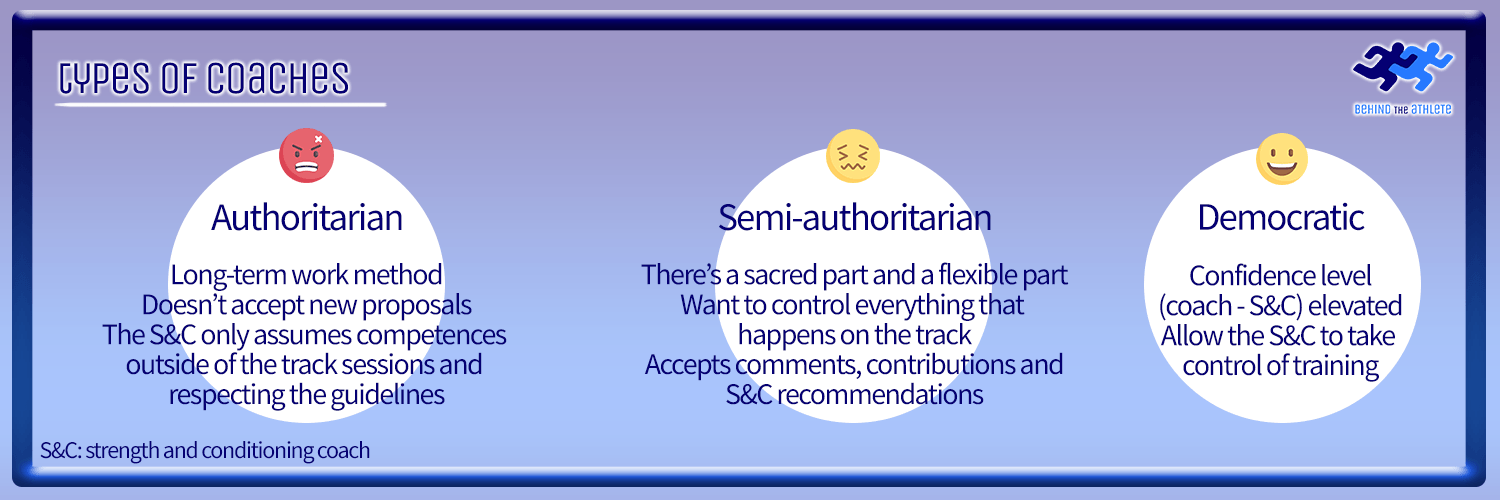We can consider a team as a family if we adopt the proposal the different parental education styles created by Diana Baumrid, a German psychologist. In this way, we can establish a classification of coaches based on their level of flexibility to share competencies.
This classification will let us create a proposal, in order to recognize what is the best way for the strength and conditioning coach (S&C) to organize his/her area and duties, to achieve the optimal level of performance for the players and the team, which is the main goal.

1. Authoritarian Head Coach.
He works with a method of work developed over the years, thinks that it works and doesn’t want to change it or accept new proposals to structure the training.
Maybe, because of his insecurity, lack of confidence, because his own method always has worked well or just because he wants to be him who assumes full responsibility. In this case, the S&C will have his own duties out of the court, probably just in the weight room.
Proposal:
→ The smartest intervention would be analyze everything that head coach is doing with the team during workouts: what type of training, what exercises, how training loads are manage, what is the tendency more common about rest time and work time, which metabolic systems are more used, what is the level of specificity in exercises, what is the game strategy, etc. Then, with all this information, the S&C should create his/her sessions in order to complement what players need to develop this game strategy. Head coach maybe could not believe in S&C’s work, but S&C can use his/her work to make players realize how important is.
2. Semi-authoritarian Head Coach.
He doesn’t want to abandon his training patterns, he still wants to be able to control what happens on the track, but he accepts comments, contributions and recommendations from the physical trainer.
We can say that for him, there are a lot of things that cannot be touched or changed, but he is ready to listen the expert in sport science.
Proposal:
→ The S&C should be ready to recognize what really matters for the head coach and cannot be touched. Then, when the opportunity to add something appears, it has to be well used, not to look good but to take advantage and be useful, making head coach part of the process, giving value to him/her when content needs to be chose, and justify the training load structure which is considered more appropriate.
3. Democratic Head Coach.
The level of confidence from this Head Coach in his/her S&C will be really high because this type of coaches takes risks to improve, they are not afraid to try new things when the team can be beneficiary. They feel comfortable delegating tasks and duties.
This is the ideal situation because the S&C can track and organize all the training loads and it will be necessary a high level of communication and teamwork between the staff.
Proposal:
→ When the game model for the team is defined, the S&C will plan all the workouts in terms of metabolic systems, work times, rest times, intensity, volume, etc. Then, coaches will fill the plan with content, according to their tactical, technical and strategic goals.
The same situations can be organized in many different ways, so one is going to choose what matters to work, and the other one will choose how.
Success will be determined by the goals that we chose as a team at the beginning. Realize that in different environments and with different people is not possible to do the same things is going to help in our path to succeed.
If we could understand the uncertainness of team sports, the next step will be to understand and adapt ourselves to different head coach profiles.
The summary in one image.

